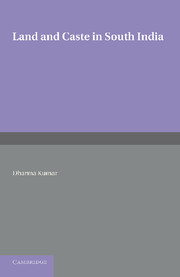 Land and Caste in South India
Land and Caste in South India Book contents
- Frontmatter
- Dedication
- CONTENTS
- List of Tables and Figures
- Acknowledgements and A Note on Certain Connventions
- Abbreviations
- Map of the Madras Presidency
- PART I
- I INTRODUCTION
- II THE AGRARIAN BACKGROUND
- III FORMS OF AGRESTIC SERVITUDE
- IV THE IMPORTANCE OF AGRICULTURAL LABOUR IN THE FIRST HALF OF THE NINETEENTH CENTURY
- V OFFICIAL POLICY AND THE EMANCIPATION OF THE AGRICULTURAL LABOURER
- VI OFFICIAL POLICY: LAND TENURES AND LAND REVENUE
- PART II
- Glossary
- Bibliography
- Index
III - FORMS OF AGRESTIC SERVITUDE
from PART I
Published online by Cambridge University Press: 05 June 2016
- Frontmatter
- Dedication
- CONTENTS
- List of Tables and Figures
- Acknowledgements and A Note on Certain Connventions
- Abbreviations
- Map of the Madras Presidency
- PART I
- I INTRODUCTION
- II THE AGRARIAN BACKGROUND
- III FORMS OF AGRESTIC SERVITUDE
- IV THE IMPORTANCE OF AGRICULTURAL LABOUR IN THE FIRST HALF OF THE NINETEENTH CENTURY
- V OFFICIAL POLICY AND THE EMANCIPATION OF THE AGRICULTURAL LABOURER
- VI OFFICIAL POLICY: LAND TENURES AND LAND REVENUE
- PART II
- Glossary
- Bibliography
- Index
Summary
The evidence that there were well-developed institutions of ‘agricultural labour’ and ‘serfdom’ points to some very important facts about the agrarian structure of early nineteenth-century Madras. The terms ‘slavery’ and ‘serfdom’ may be applied to it, in so far as some agricultural labourers were bought and sold, and others were born into a state where they owed service to the masters on their lands. But of course terms drawn from European experience do not fit Indian conditions perfectly. One of the most striking and important peculiarities of the Indian forms of servitude is their close connection with the caste system. Most types of servile status were hereditary, and in general the ‘serfs’ and ‘slaves’ belonged to the lowest castes. Although this group as a whole was at the bottom of the caste ladder, there were further gradations within it, each sub-group having its articulated rights and disabilities. In fact, the caste system not only confirmed the economic and social disadvantages of the agricultural labourer, but also gave him some rights, some economic, others of a social and ritual nature.
Most important among the serf's rights was that of working on a particular piece of land. If he was born into a family ‘owned’ by a particular landholder, the landholder had the obligation to employ him on the land and pay him the customary wages. In this sense it can be argued that the labourer was not landless. But two points are very relevant here. First, although the serf may have had some right to a share in the produce of ‘his’ land, he had far fewer economic rights than the mirasdar or tenant; his share of the produce was very much smaller, and he had moreover no right to sell the land. Secondly, as we shall see, the right to work on a particular plot of land was not always granted. In Malabar the agricultural labourer was in some respects treated like a commodity of production, and even in Tamilnad his rights were very circumscribed. In early nineteenth-century Madras there was a great variety of institutional forms, ranging from slavery to completely ‘free’ hired labour. And these covered not only agricultural labourers but also domestic servants and even artisans.
- Type
- Chapter
- Information
- Land and Caste in South IndiaAgricultural Labour in the Madras Presidency during the Nineteenth Century, pp. 34 - 48Publisher: Cambridge University PressPrint publication year: 2013


